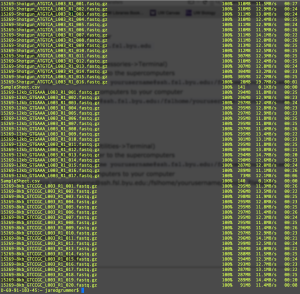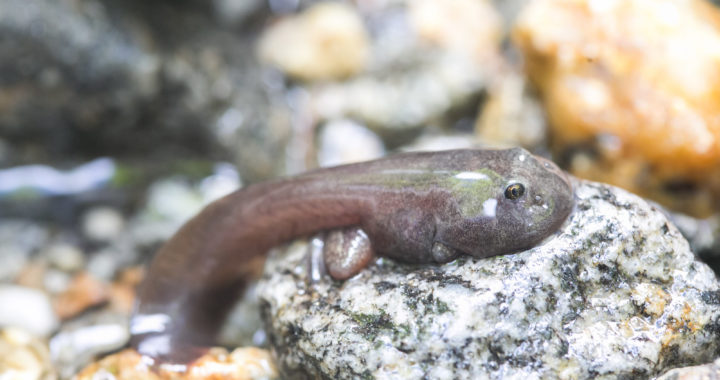We just had a paper appear online at Trends in Ecology & Evolution! The review article is about aquatic landscape genomics, but also talks generally about landscape genetics/genomics and how genetic variation is affected by the landscape. Check out the link on my Publications page!
Category Archives: News
Spatial Statistical Stream Network Workshop
I have just attended a workshop at Washington State University on spatial statistical network modeling. It is obvious that stream segments should be considered not independently but as part of a bigger network. In this workshop, we learned how to use tools in ArcGIS and R to accommodate this spatial connectivity when modeling various features of a hydrologic network. This will certainly be useful for my future analyses!
National Postdoc Appreciation Week
If you didn’t know, this week is National Postdoc Appreciation Week! Postdocs play a vital role in research, from mentoring to producing vital research. Go out and thank a postdoc in your life for what they do!
Trip to CRITFC
This past week (8/28-9/2), I visited some collaborators working for the Columbia River Inter-tribal Fish Commision at University of Idaho’s Hagerman fish hatchery. The main point of this trip was to learn the lab techniques for preparing a poolseq library, and gain a better general understanding of the method. Stephanie Harmon showed me the nitty gritty in the lab, Steven Micheletti showed me around the bioinformatics of processing and analyzing this type of data, and Nate Campbell talked me through some of the theoretical aspects of this method. It was an extremely productive visit, supplemented by the beauty of the surroundings and trout fishing in the mornings and evenings. Thank you to CRITFC and all those I met in Hagerman for a great trip!
Out with the PhD, in with the PostDoc!
I am super excited to announce that on June 8th, I successfully defended my PhD! I have now moved up the road to Vancouver, BC, where I have just started a postdoctoral research position in the Biodiversity Research Centre at the University of British Columbia. I am advised by Drs. Rick Taylor, Michael Whitlock, and Trish Schulte. To find out a little more about my postdoc research, check out my Research page. I’m excited not only to study the genomics of adaptation in rainbow trout, but also to leave the U.S. at this time!
Article on Agama species diffusion available!
My advisor and I, along with a long string of co-authors, have recently published a paper on the phylogeography of Agama lizards in central Africa! The article was published in Systematics and Biodiversity, and you can find it here. Our results showed that much of the movement of these species has been fairly recently, and although some species range centers have not shifted much, others have moved substantially, likely tracking environmental change over time. Check it out!
Manuscript on Ascaphus Population Genetics Published!
Through a generous grant from the Seattle City Light, we have just published a paper in Conservation Genetics on the effect of hydroelectric dams on coastal tailed frogs in the North Cascades National Park! Click here to find the paper on Conservation Genetics’ website. We found evidence for population structuring down-river of the oldest dam, suggesting the power of SNPs in detecting recently created population structure. However, overall, migration is high in this system, indicating that tailed frogs don’t appear to be drastically affected by this hydroelectric operation!
We published a “sister” article from this same study system in which we surveyed for Batrachochytrium dendrobatidis, the fungal pathogen that causes the often-fatal amphibian disease chytridiomycosis. My interpretation as a scientist: we did not discover B. dendrobatidis in this study system. My interpretation as a naturalist: hooray!! You can find that article here.
You can get distilled versions (with pictures!) of this research on UW Biology’s blog, as well as the Burke Museum’s blog.
Come on by the Burke Museum on UW’s campus until April 19th to see more on this research in the Wild Nearby Exhibit!
Whole Genome Sequence Data are Here!
I just received my first lane of whole genome sequence data from the DNA Sequencing Center at BYU! It will be a serious task to begin assembling 80 GB of data, but it will be a great challenge!
Photo makes the cover of Journal of Mammalogy
A photo I took of a ringtail (Bassariscus astutus) 8 years ago while working on Mexican spotted owls in the Guadalupe Mountains of SE New Mexico has made it to the cover of the Journal of Mammalogy! My image accompanies a study by Robert Lonsinger and colleagues looking at the fine-scale genetic structure of ringtails in these sky-island mountains. You can find the article here, and a link to the cover image in my Photography page here. Awesome!
I’m a Boeing Fellow!
I have recently been selected as one of three graduate students at the University of Washington to receive a Boeing International Fellowship for the 2015-’16 school year! This fellowship is available to all graduate students at the UW and will provide salary for one quarter while I perform fieldwork in Argentina for my dissertation research. I am ready to tackle the remainder of my dissertation research, armed with my recently acquired DDIG and this fellowship. Stoked!

